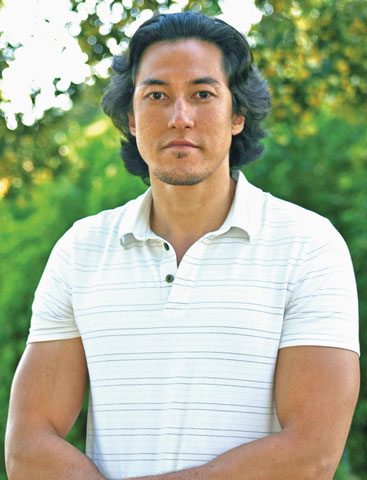
Paul Chappell
When Paul Chappell, a 2002 graduate of the United States Military Academy at West Point, told his Korean mother that he was leaving the Army after seven years and reaching the rank of captain, she vented: "Are you out of your mind? Nobody is going to hire you. It's bad enough that you look Asian, but you're also part black. Nobody is going to give a job to a black man who looks Asian."
This forecast, bleak as it was but still plausible, didn't pan out. In 2009, Chappell's book Will War Ever End?: A Soldier's Vision of Peace for the 21st Century won the attention of officials at the Nuclear Age Peace Foundation in Santa Barbara, Calif. He was hired as the nonprofit's Peace Leadership director.
In late September and early October, Chappell was in Washington for a series of talks, opening with the 40th annual Thomas Verner Moore lecture of St. Anselm's Abbey and sponsored by the School of Theology and Religious Studies at The Catholic University of America. He spoke at five of my college and high school classes, as he did three years ago.
If a difference exists between this latest visit and the earlier one, it is the recent publication of his book The Art of Waging Peace: A Strategic Approach to Improving Our Lives and the World. With chapter titles that include "How West Point Trained Me for Peace Activism" and "The Deceptive Beauty of War," Chappell's well-honed prose combines autobiography, historical analysis and reasoned alternatives to military violence. Chappell's personal story of moving from waging war to waging peace places him in the company of past and current icons who believed that moral force and the forces of truth, resistance and negotiation are superior to and more effective than violent military force. Among them are former warriors such as Sargent Shriver, Howard Zinn, Philip Berrigan, Garry Davis, Andy Jacobs, Mark Hatfield, George McGovern and Francis of Assisi.
Chappell's transition could easily be the unlikeliest. His childhood was wracked with violence, both receiving and giving it. Growing up in Alabama in a dysfunctional household, he suffered repeated beatings from his half-black, half-white father, a veteran of the Korean and Vietnam wars who returned home emotionally scarred by his combat experiences. He suffered paranoia, and suicidal and murderous impulses. "Throughout my childhood," Chappell writes, "I saw my father lose his grip on reality, and this frightening behavior caused me to struggle with my own sanity. As I grew older, the trauma I inherited from my father caused me to embark on a relentless search for understanding, peace and trust."
Outside the home, where schoolmates bullied him because of his multiethnic background and appearance, he was a troubled student. Occasional outbursts of violence led to a dismissal from an elementary school and a high school suspension. A turning point came in the eighth grade when he asked a teacher, "Where does violence come from?" She said, "Human beings are naturally violent and warlike. War is part of human nature, because people are evil. It is human nature to be greedy, hateful, and selfish."
Chappell recalls thinking that the answer made no sense, even to his adolescent mind: "If humans are naturally violent and warlike, why does war drive so many people like my father insane? From that point onward, I was determined to study war the way a doctor studies an illness."
The Art of Waging Peace is Chappell's fourth book. In my classes, he drew on all of them to ground his argument that violence is a learned behavior and, rather than being natural, it is the opposite. "The most effective way to kill human beings and not experience guilt or remorse," he says, "is to imagine they are not human beings. This involves viewing people as subhuman -- so we can rationalize the act of killing -- or seeing people as evil monsters so we can perceive the act of killing as a necessary purging of evil from the world."
Pressured by his parents to seek a military career, he gained entry to West Point with his strong high school grades and SAT scores. His time at the academy and seven years of soldiering after that, including a high-risk posting in Iraq, led to the conclusion that "almost everything our society and the media teach us about war is a distortion of the truth." So began a period of self-education in military history, psychology, nonviolence and empathy. Without West Point and the Army, it's doubtful the introspection would ever have happened.
My students had their minds opened and hearts stirred by Chappell's talks and his conversational style of speaking. Now 33, he is a polished writer and peace educator whose inclusion in the American peace movement is secure.
[Colman McCarthy directs the Center for Teaching Peace in Washington and teaches courses on nonviolence at four universities and two high schools.]




